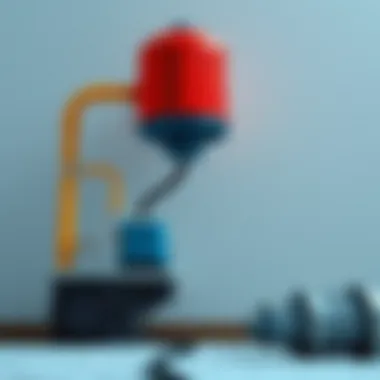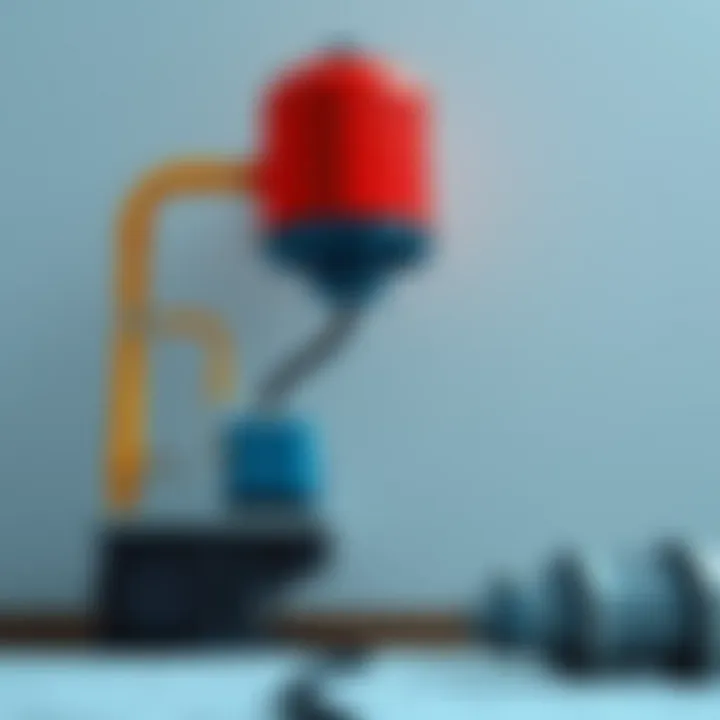Understanding Radon Gas: Sources and Health Risks


Research Context
Background Information
Radon gas, a naturally occurring radioactive gas, is formed from the decay of uranium found in soil, rock, and water. Understanding its origins is crucial for grasping the implications it has on both health and the environment. Radon is colorless, odorless, and tasteless, making it nearly impossible for individuals to detect without proper equipment. As it migrates through the soil, radon can seep into buildings, posing significant health risks to inhabitants.
Importance of the Study
The study of radon gas holds substantial relevance, particularly in the fields of public health and environmental science. Due to its connection to lung cancer and other health issues, awareness and detection of radon are paramount. Furthermore, the presence of radon in homes and schools necessitates effective mitigation strategies to ensure safety. This article seeks to provide an extensive overview of radon’s origins, behaviors, and the pathways through which it infiltrates human environments, laying the groundwork for a comprehensive understanding of its implications.
Discussion
Interpretation of Results
Radon's behavior in geological and anthropogenic contexts reveals its intricate relationship with human activities. Factors such as construction practices, the types of building materials used, and local geology significantly influence radon levels within indoor spaces. In areas with high natural uranium content, radon concentrations can rise, necessitating active monitoring and mitigation efforts. Studies have shown that homes built on uranium-rich granite formations are particularly susceptible to elevated radon exposure.
Comparison with Previous Research
Previous research highlights a fixed connection between radon exposure and lung cancer. For instance, the Environmental Protection Agency reported that radon is the second leading cause of lung cancer in the United States, trailing only behind smoking. Analyses conducted in the last two decades have shown a growing awareness of radon management, leading to better public policies and testing initiatives.
"Understanding radon gas is not just about scientific inquiry; it’s about protecting lives and enhancing the quality of life by eliminating health risks in our homes."
In light of this historical context, our current analysis recognizes the iterative nature of research surrounding radon. Emerging studies continue to refine our understanding of effective mitigation strategies while underscoring the need for widespread public awareness and education.
Culmination
The investigation into radon gas origins and implications serves as a vital aspect of public health discourse, emphasizing the importance of comprehension and action regarding radon exposure. With comprehensive knowledge, we can implement effective measures to protect our communities against the understated dangers of this radioactive gas.
Preamble to Radon Gas
Radon gas is a topic of significant relevance in discussions about environmental health and safety. Its natural origin, potential health risks, and the ways it can infiltrate our living spaces make it a critical subject for public awareness and research. Radon is a colorless, odorless gas that is produced from the decay of uranium, a process that happens in the earth's crust. Given its silent presence, few people are aware that they may be living or working in areas where radon concentrations are above acceptable levels.
Understanding radon is essential for multiple reasons. Firstly, it’s crucial for educating the public on how to test their homes for this gas. Many people may not realize that radon can accumulate in basements and other low-lying areas of buildings. Ignorance can lead to serious health implications, particularly when considering that radon has been linked to lung cancer, making it the second leading cause of the disease after smoking.
In addition to health risks, radon’s geological origins are important when considering the factors associated with its release into the environment. Different rock types, soil properties, and geological formations impact how radon is released, transported, and ultimately accumulates. This article delves deep into these origins, the implications of radon in the environment, and the health risks it poses, aiming to shed light on a subject that is often overlooked.
Defining Radon
Radon is a naturally occurring radioactive noble gas that has an atomic number of 86. Unlike many gases, it is inert and does not readily react with other elements. This quality allows it to travel freely through soil and rock, eventually making its way into the air and water supplies. Radon is produced during the decay of uranium-238, which is abundant in various rock formations, particularly granite, shale, and phosphate rock. The three isotopes of radon are radon-222, radon-220, and radon-219, with radon-222 being the most prevalent in the context of health concerns.
Since radon is a gas at room temperature, it can easily move through soil pores and enters buildings through cracks in floors, walls, and foundations. However, not all geographical areas are at equal risk; zones with high natural uranium deposits are often more susceptible to elevated radon levels. Knowing where radon levels might be high can help homeowners and builders take necessary precautions. Additionally, standard units for measuring radon concentrations are picocuries per liter, and awareness of these measurements is vital for understanding exposure risks.
History of Radon Discovery
The story of radon discovery is quite fascinating, highlighting the evolution of scientific understanding of radioactive elements. Radon was first recognized in the late 19th century, although its origins were initially misunderstood. Scientists were studying uranium and its decay products when they stumbled upon this gas. In 1899, British physicist Ernest Rutherford, along with his colleague Friedrich Otto Giesel, successfully isolated radon while conducting experiments on radioactive gases. However, it was not until 1900 that they fully identified it as distinct from other gases in the decay chain of uranium.
By the 1920s, further studies began to reveal radon’s potential health risks, as researchers noted its connection to lung disease, particularly in miners who were exposed to elevated levels in confined spaces. Thus, the understanding of radon transitioned from a scientific curiosity to a significant public health concern. As research progressed, public health campaigns highlighted radon testing and mitigation strategies, slowly changing how communities view this otherwise invisible threat.
Understanding the history of radon discovery not only illustrates the scientific journey but also underscores its present-day importance. While radon gas has been known to science for over a century, it remains a subject demanding attention, especially in light of new research concerning its health impacts and environmental behavior.
Natural Sources of Radon
Understanding the natural sources of radon is crucial for grasping how this gas emerges in various environments, especially in relation to human health and safety. Radon is a product of radioactive decay resulting from uranium and thorium found in soil, rock, and water. It seeps into buildings through cracks in foundations and other openings. This section unpicks the geographical origins and interaction of radon with the environment, providing insight into its pathways into our lives.
Geological Origins
Uranium Decay Process
The uranium decay process stands at the heart of radon generation. Uranium exists naturally in minute quantities within the earth's crust, and as it decays, it transforms through several isotopes eventually leading to radon gas. This decay is notable because it occurs over long timeframes, meaning that the radon gas can linger in the environment for extended periods before making its way into homes. A standout feature of this process is that it doesn't occur uniformly; regions with higher uranium concentrations can yield considerably more radon. Understanding this decay helps paint a clearer picture of where radon might be a concern, reinforcing why it's pertinent for residents in certain geographical hotspots to be aware of their radon levels.
Types of Rocks and Soil Associated with Radon
When discussing the types of rocks and soil associated with radon, granitic and sedimentary rock types come to the forefront. These rock types are not just carriers of uranium; they also have a distinct capability to harbor radon. Granitic rocks, rich in quartz and minerals containing uranium, commonly release radon gas as these uranium deposits decay. The unique feature lies in their porosity; the amount of space within the rock allows radon to form and migrate more easily than in denser rock types. This characteristic is particularly beneficial in understanding radon's prevalence in areas where granitic rocks dominate. Meanwhile, wet soils can also generate radon, especially where these rocks are near the surface. Understanding these connections aids in mitigation efforts as it highlights the geological conditions that may elevate radon risks in specific locales.
Radon in Groundwater
Interaction with Aquifers
Radon does not limit itself to air; it finds its way into groundwater as well. This interaction with aquifers is significant because water is a vital resource for many households. Groundwater can become a source of radon if the aquifer intersects with uranium-rich rock formations, effectively channeling radon into the water supply. The slow movement of water through porous rocks allows radon to accumulate and dissolve, which can lead to increased concentrations in municipal water systems. This characteristic makes understanding these interactions critical, as water treatment processes must account for radon levels to ensure public safety.
Radon Transport Mechanisms
Radon transport mechanisms play a crucial role in how radon migrates from its source into both air and groundwater. Two primary mechanisms are diffusion and advection.
- Diffusion refers to the process where radon moves from areas of high concentration to lower concentration, an essential aspect of its movement within soil and rock layers.
- Advection, on the other hand, occurs when radon is carried away by moving groundwater, which can substantially increase exposure risks when water enters homes through wells or taps.
This duality of transport explains why even low levels of radon in the ground can translate to significant levels in structures that utilize groundwater, underlining the need for constant monitoring and effective measures in radon management.
Understanding these sources and pathways of radon is indispensable for officials and the general public alike, informing policies and promoting awareness about air and water safety.
Overall, recognizing the natural sources of radon reveals not just the gas's origins but its broader implications for health and safety. Awareness, detection, and mitigation strategies rooted in our understanding of these sources play a vital role in protecting communities against radon exposure.
Radon Emission in the Environment
Understanding how radon gas interacts with the environment is critical to assessing both its sources and potential health risks. This section delves into the factors that influence radon emissions and how they can vary with seasons. Given that radon is often referred to as an invisible threat, analyzing its environmental behavior allows us to devise better mitigation strategies.
Factors Influencing Emission Levels


Soil Permeability
Soil permeability plays a pivotal role in how radon gas emits from the ground. Essentially, it refers to how easily fluids (in this case, gas) can move through soil pores. Soils with high permeability – think sandy or gravelly types – allow radon to escape more freely into the atmosphere. \n This permeability has key characteristics: a soil with larger pores or fewer particles packed tightly can facilitate easier gas movement. This is a beneficial feature to understand in the context of radon emissions, as high permeability can lead to elevated radon levels in residential areas. Conversely, dense clay soils restrict radon escape, resulting in lower concentrations.
One unique aspect of soil permeability is how it can change over time due to various factors like landscaping or construction. For instance, filling a low-lying area with gravel can drastically change how radon interacts with that space. In this scenario, while soil permeability provides advantages for understanding radon emissions, there are disadvantages too; for instance, construction in high-permeability zones may inadvertently increase radon exposure for future inhabitants.
Climate Effects
Climate is another significant factor affecting radon emissions. Temperature and precipitation influence how radon behaves in the environment. For example, during dry spells, radon levels may spike because reduced soil moisture allows more gas to escape. Conversely, prolonged wet conditions can dampen emissions by saturating the soil, limiting gas release.
A key characteristic of climate effects on radon emissions is the interplay between temperature and pressure differences. On cooler days, when indoor spaces are heated, a pressure differential can draw radon in from the outside air, making homes susceptible to higher concentrations. This phenomenon highlights the importance of understanding climate variations when managing radon risks.
Moreover, extreme weather events like storms may also exacerbate the emission levels when soil is disturbed, increasing permeability and allowing for more gas to escape. Thus, climate influences not only the amount of radon emitted but also presents challenges for public health awareness and mitigation strategies.
Seasonal Variations of Radon Concentrations
Radon concentrations in the environment are not static; they fluctuate seasonally, reflecting changes in temperature, soil moisture, and atmospheric pressure. Typically, winter months see higher indoor radon levels because homes are closed up tight to conserve heat, creating a perfect storm for gas accumulation. The colder temperatures outside often correlate with reduced ventilation, trapping radon indoors.
On the flip side, summer brings more opportunities for ventilation and moisture influx due to rain, which generally reduces indoor radon levels. However, fluctuations can occur; a cool summer evening might still allow radon to surge as doors and windows remain shut. Understanding these patterns is fulcrum for developing effective public health strategies.
In summary, knowing the dynamics of radon emissions in the environment is essential for identifying risks and implementing safety measures. Awareness of factors like soil permeability and climate effects can reveal patterns of how radon behaves. It also guides construction practices and fuelled community education with hints of prevention, health initiatives, and awareness campaigns.
"The invisible killer requires our visible attention."
For more information about the effects of radon emissions and methods of measurement, visit EPA or read up on studies at NIH for health-related research.
Radon's Pathway into Buildings
Understanding how radon gas makes its way into buildings is crucial for assessing risks and implementing effective safety measures. Radon can seep into homes from the soil, where it collects, necessitating an awareness of its pathways and entry points. The implications of radon infiltration extend beyond individual homes to encompass public health concerns, making effective management essential.
Common Entry Routes
Cracks in Foundation
Cracks in the foundation are perhaps the most common entry point for radon gas into buildings. These fissures, often small and unnoticed, can serve as channels for gas accumulation. One significant characteristic of foundation cracks is that they create a direct link between the soil below and the interior environment, permitting radon molecules to infiltrate living spaces without much obstruction.
When foundations settle or shift, it’s natural for hairline cracks to appear, which is a real concern for homeowners. The nature of these cracks often makes them a popular choice for radon entry as their dimensions can, however, vary greatly.
Advantages:
- They often go unnoticed until radon tests reveal high levels.
- Addressing foundation maintenance can also enhance home integrity as a bonus.
Disadvantages:
- They can result in larger issues if not monitored, leading to costly repairs.
- The radon concentration might increase if these cracks are not sealed, worsening health outcomes.
Construction Materials
Another notable aspect is the choice of construction materials, which can influence radon’s infiltration potential. Certain materials used in home construction, such as concrete and granite, can emit radon gas themselves due to their uranium content. Homes built with these substances might face increased radon levels depending on their geographical setting.
The key characteristic of these materials is that while they are durable, not all offer the same level of protection against radon. Understanding material properties can guide homeowners in making informed decisions during renovations or new constructions.
Advantages:
- Awareness can lead to better design choices, aiming for radon-resistant construction.
- Increased knowledge can help in deciding on effective remediation strategies, should radon levels rise above safe thresholds.
Disadvantages:
- Not all homeowners are aware of these potential risks, leading to insufficient mitigation efforts.
- Heavy reliance on natural materials without testing can compound radon presence in unmonitored areas.
Factors Accelerating Entry
Ventilation Practices
Ventilation practices in a building can significantly affect how radon enters a property. Poor ventilation often leads to increased indoor air pollution, which in turn allows radon levels to rise. A key characteristic of ventilation is its role in air exchange; homes that lack adequate airflow tend to trap radon gases indoors, resulting in dangerously high concentrations.
Good ventilation practices help mitigate this risk by enhancing air circulation and pushing radon out. However, maintaining a balance is tricky; over-ventilation can lead to energy loss, which is a consideration for many homeowners.
Advantages:
- Proper ventilation not only helps prevent radon accumulation but also improves overall air quality.
- It’s a cost-effective strategy when integrated at the construction phase.
Disadvantages:
- In older homes, retrofitting for better ventilation may involve considerable effort and expense.
- Insufficient understanding of the relationship between ventilation and radon can lead to ineffective measures.
Basement Presence
Basements frequently exist as a gateway for radon entry. These below-ground spaces are generally more susceptible to radon infiltration due to their proximity to the soil. The predominant characteristic of basements is their cool, damp environment, which is often conducive to radon accumulation.
Many homeowners choose to modify or inhabit basements, yet they might overlook potential radon hazards. Awareness of this unique feature is vital, as a poorly constructed or ventilated basement can see radon levels soar, pushing occupants into health risks unknowingly.
Advantages:
- Basements can be made radon-resistant with proper construction methods from the get-go.
- Enhanced living space, when safe, can significantly increase property value.
Disadvantages:
- If unaddressed, basements can become a major health hazard, often neglected by homeowners.
- The initial setup cost for radon mitigation can deter necessary changes, leading to long-term risks.


It is essential to take proactive measures in understanding and managing radon’s pathways into buildings. Without proper attention, radon exposure can remain a hidden threat, with potentially severe health implications.
Health Implications of Radon Exposure
Understanding the health implications of radon exposure is crucial, especially given the gas’s potential to contribute to serious health issues, particularly lung cancer. The rise in attention towards indoor air quality has positioned radon as a significant public health consideration. It’s essential to recognize that radon, while a naturally occurring gas, becomes hazardous when accumulated in enclosed spaces, like homes and workplaces. Tackling the risks associated with radon can lead to improved public health outcomes and heightened awareness about indoor environmental quality.
Radon and Lung Cancer Risks
Radon exposure is the second leading cause of lung cancer after smoking. According to the U.S. Environmental Protection Agency (EPA), an estimated 21,000 lung cancer deaths each year are attributed to radon. This gas decays into radioactive particles that can get trapped in the lungs when inhaled. Over time, these particles emit radiation which can damage lung cells and potentially lead to cancer.
Research shows that individuals exposed to high radon levels for extended periods are at greater risk. The risk is cumulative; the longer one is exposed, the higher the chance of developing health complications. It's not just a matter of how much radon is present but also the duration of exposure that paints the full picture regarding lung cancer risks. The EPA sets action levels, advising homeowners to take remedial steps when radon concentrations exceed 4 pCi/L (picocuries per liter).
Vulnerable Populations
Smokers vs. Non-Smokers
The interaction between smoking and radon exposure significantly escalates lung cancer risks. Smokers are particularly vulnerable; the combination of smoke and radon has a multiplicative effect on cancer risk. Smokers who are exposed to high radon levels may face a risk that is many times higher than non-smokers. This connection emphasizes the importance of radon testing in homes, especially those where smoking occurs.
Radon is undetectable by sight or smell, hence education and awareness are vital. Initiatives encouraging smoking cessation combined with radon reduction strategies could be beneficial.
Occupational Exposure
Occupational exposure is another pressing issue. Certain professions, like underground miners, face higher radon levels in their working environment. The unique feature of occupational exposure lies in the sustained and often uncontrolled nature of radon levels in some workplaces. Those in specific trades are legally required to monitor and mitigate exposure. The long-term effects can compound over time, leading to similarly high lung cancer statistics seen in the general population exposed to radon at home.
Detection and Measurement of Radon
Understanding how to detect and measure radon is paramount in managing its potential health risks. Radon is a silent intruder, seeping into homes and buildings without any immediate signs. Early detection is key to preventing long-term exposure, which could lead to serious health issues, including lung cancer. Combining appropriate measurement practices with robust detection techniques can notably lessen the exposure risk for individuals and families.
Techniques for Radon Detection
Continuous Monitors
Continuous monitors offer real-time data on radon levels. They are electronic devices that consistently measure radon concentration in the air, providing a comprehensive overview of its fluctuation over time. This feature makes them particularly valuable for homeowners and researchers alike.
The key characteristic of continuous monitors lies in their ability to provide instant readings, enabling users to respond immediately to any spikes in radon levels. They are deemed a popular choice due to their efficiency and reliability, allowing users to stay informed about indoor radon levels effortlessly.
However, the cost can be prohibitive for some. These monitors often require a more substantial initial investment compared to other methods. It's also worth noting that while they offer precision, they may need regular maintenance to ensure accuracy.
Passive Detectors
Passive detectors present a simpler, yet effective alternative to continuous monitors. These devices rely on the radon gas itself to be absorbed, allowing for a passive collection of samples over time. They do not require electricity, making them suitable for many situations where convenience is paramount.
The highlight of passive detectors is their affordability and ease of use. Many individuals opt for this method during initial screenings because they can simply place the device in a desired location and leave it for several days or weeks. This hands-off aspect broadens their appeal, especially for those new to radon testing.
However, passive detectors come with certain limitations. They do not provide the same level of real-time data as continuous monitors, meaning that any significant changes in radon levels during the testing period might be missed. Moreover, careful placement is essential to ensure accurate readings, as local environmental factors can affect results.
Interpreting Radon Levels
Understanding how to interpret radon levels is critical for ensuring safety and compliance with health guidelines. The following are key aspects to consider in this respect.
Radon Level Guidelines
Radon level guidelines are established benchmarks created to help individuals assess the safety of indoor air quality concerning radon exposure. Health organizations recommend action levels, typically set at 4 picocuries per liter (pCi/L). Exceeding this threshold suggests a need for remediation efforts to reduce radon levels within buildings.
The unique feature of these guidelines is that they provide clear directives that inform homeowners about when to take action. They serve as a crucial tool for public health officials as well, contributing to broader health initiatives aimed at mitigating radon risks across communities.
However, it's vital to acknowledge that guidelines can vary by region, reflecting local geological conditions and building practices. Such variability necessitates ongoing learning and adaptation, which might complicate comprehension for some.
Understanding Measurement Units
Understanding the measurement units used in radon testing is equally significant as it helps demystify reporting and communication around radon risks. Radon levels are typically measured in picocuries per liter or becquerels per cubic meter, with these units showing the concentration of radon in a specific volume of air.
The key characteristic of these measurement units is their precision. They enable accurate quantification of radon, facilitating comparisons across different readings and studies. Clarity in these units enhances the overall comprehension of findings for both public health professionals and concerned individuals.
Despite the clarity they offer, some might find the scientific nomenclature intimidating. This complexity can pose a barrier to effective communication among stakeholders about radon risks and concerns. Breaking down these measurements into more understandable terms could foster greater public engagement and awareness.
"Knowledge is power—especially when it comes to understanding and controlling radon exposure."
This section on the detection and measurement of radon underscores the importance of promptly identifying and addressing potential radon threats, making informed decisions that ultimately safeguard health.
Mitigation and Control Strategies
Mitigating the risks associated with radon gas is essential for protecting public health and ensuring indoor air quality. As a naturally occurring radioactive gas that poses a significant health risk when allowed to accumulate, practical strategies for its control are key to reducing exposure levels. Understanding the importance of effective mitigation can lead to safer living environments and informed decision-making for residents, builders, and policymakers alike.
Radon Mitigation Techniques
Sub-slab Depressurization
Sub-slab depressurization stands out as a leading method for radon mitigation in residential and commercial properties. This technique involves installing a ventilation system beneath the home’s foundation, which creates a negative pressure that prevents radon gas from entering the building. Its primary benefit lies in its effectiveness; studies have shown it can reduce radon levels significantly — often by as much as 99%.
One key characteristic is the simplicity of its design; pipes are strategically placed to draw air from under the slab and vent it outside, often through the roof. Additionally, it relies on basic principles of air pressure, making it a practical solution that requires minimal intervention with the structure itself.
However, potential downsides exist. For instance, the installation can be costly, and ongoing maintenance is necessary to ensure the system continues to function effectively. Homeowners must also be aware of how it interacts with the general ventilation of the home to avoid any unintentional air quality issues.
Ventilation Improvements
Improving ventilation within a dwelling is another widely recommended radon mitigation strategy. By increasing airflow, homes can generally dilute radon levels, making the air safer to breathe. This method involves enhancing existing ventilation systems or creating new pathways to allow fresh air to flow throughout the space.


Key to its advantage is the natural approach it takes to mitigating radon. Rather than relying on electrical systems or complex apparatuses, ventilation improvements can effectively capitalize on outdoor air, resulting in lower operational costs in the long run.
On the downside, simply increasing ventilation might not be sufficient in high radon areas, and effectiveness can vary based on the existing structure. Furthermore, in extreme weather conditions, increased outdoor air can lead to higher heating or cooling costs, which is something homeowners need to consider when deciding on a mitigation plan.
Building Design Considerations
The design phase of a building offers a critical opportunity to prevent radon entry even before construction begins. Implementing radon-resistant construction techniques can significantly limit the amount of radon entering a structure, making it a vital aspect of long-term mitigation.
Radon-Resistant Construction
Radon-resistant construction involves various design features and construction practices intended to minimize radon accumulation within new buildings. Common practices include using sealed foundations with vapor barriers and ensuring properly designed drainage systems. The incorporation of these elements reflects an increasingly proactive approach to public health.
One of the standout characteristics of this strategy is that it addresses radon from the ground up — literally. By embedding these features into the building's design, potential radon problems can be averted before they arise, often at a minimal additional cost during the construction phase.
However, while this method is quite effective, it might also face resistance from those unfamiliar with its benefits or accustomed to traditional building techniques. Also, it’s important to be aware that even the best designs may not fully eliminate radon, and ongoing monitoring is necessary.
Site Selection
The criteria for site selection can greatly influence the presence of radon in a new construction project. Some locations are naturally prone to higher radon levels due to underlying geology, making the careful consideration of land characteristics paramount. Involvement of geospatial analysis early in the selection process can yield significant benefits.
A critical aspect of this strategy is its foresight; by identifying potentially hazardous areas beforehand, builders and developers can avoid costly remediation efforts later. Selecting a site with low radon potential can significantly reduce the need for complex mitigation post-construction.
Yet, choosing an ideal site does have limitations; factors such as cost, accessibility, and local regulations often play a role in site selection decisions. Individuals must balance ideal radon conditions with other necessary considerations, ensuring a comprehensive and strategic approach to land development.
Ultimately, combining various radon mitigation strategies is often the best pathway to ensure lower levels of this hazardous gas in homes and buildings.
While there's no single solution that fits all scenarios, each strategy contributes to a larger picture of health and safety in relation to radon exposure.
Regulatory Framework and Public Awareness
Addressing the regulatory framework and raising public awareness about radon gas is essential for safeguarding health and minimizing the risks associated with exposure. The interplay between legislation and community education shapes how effectively society can counteract the dangers of radon. As communities confront the reality of radon gas, understanding the regulations and awareness initiatives lays a foundation for proactive health measures.
Guidelines from Health Organizations
Health organizations worldwide have developed comprehensive guidelines that serve as the backbone of the regulatory landscape concerning radon exposure. Agencies such as the World Health Organization and the Environmental Protection Agency have recognized the necessity for clear recommendations. These guidelines reflect a thorough understanding of radon’s risks, emphasizing monitoring and mitigation.
"Radon is a serious health risk that can be prevented with proper measures and awareness."
The guidelines include:
- Radon concentration levels: Establishing action levels for radon concentration in homes and workplaces. These levels often serve as benchmarks for determining when intervention is necessary.
- Testing recommendations: Encouraging regular testing of indoor air and drinking water sources, especially in areas with known radon hazards. This proactive approach aims to identify potential issues before they escalate.
- Mitigation standards: Offering best practices for radon mitigation, which can include ventilation systems and structural improvements to reduce levels within buildings.
In essence, guidelines for radon provide clarity and direction for both individuals and public officials, ensuring that efforts to tackle radon are grounded in scientific evidence and best practices.
Community Education Initiatives
Raising awareness about radon gas is equally critical in promoting public health. Community education initiatives take center stage in this effort. They aim to equip citizens with the knowledge to protect themselves and their families from the risks of radon exposure.
Public Health Campaigns
Public health campaigns play a pivotal role in broadening the understanding of radon. These campaigns often focus on disseminating information about radon sources, health risks, and testing. What sets these campaigns apart is their community-centric approach, often utilizing local events, workshops, and social media to reach diverse audiences. This outreach has proven beneficial for several reasons:
- Accessibility of information: Campaigns typically provide information in a straightforward manner, making it easier for those less familiar with scientific jargon to grasp the health risks associated with radon.
- Engagement opportunities: By hosting public forums and screenings, campaigns foster direct interaction, encouraging community members to ask questions and share experiences.
For instance, local health departments might use community gatherings to distribute free radon test kits, thus encouraging residents to engage actively in monitoring their home environments.
School Programs
School programs addressing radon awareness encourage an early understanding of environmental health among students. These initiatives often include curriculum components that educate children on radon, its sources, and its implications. One of the compelling advantages of school programs is their ability to reach not just students but also their families, creating a ripple effect of awareness in the community.
- Incorporation into science curricula: Schools can integrate radon studies into science classes, promoting discussions on geology and environmental health.
- Workshops for parents: Often, workshops for parents accompany school initiatives, fostering an environment where families can learn about radon together.
A unique feature of these programs is their role in fostering a sense of responsibility among the younger generation. While they provide valuable information, they also encourage students to advocate for radon testing in their homes and communities.
In summary, both public health campaigns and school programs are instrumental in filling the knowledge gap surrounding radon gas. The combined efforts of these initiatives help nurture a well-informed public, encourage testing, and ultimately, contribute to reducing health risks associated with radon exposure. By bridging the gap between regulatory measures and community knowledge, society can adopt more robust and effective strategies in combating the challenges posed by radon gas.
Future Directions in Radon Research
As we delve into the future directions in radon research, it's crucial to emphasize the importance of understanding the dynamics of radon gas and its implications for public health and environmental safety. With ongoing advancements in various fields, such as geochemistry, environmental science, and public health, the trajectory of radon research is set to evolve tremendously. The insights derived from this work could potentially reshape policies and practices directed at minimizing risks associated with radon exposure.
Advances in Detection Technologies
The field of radon detection is continuously advancing, pushing the envelope on how we identify and measure radon levels in buildings and the environment. Recent developments have seen the evolution from simple charcoal canisters to sophisticated electronic detectors that offer real-time monitoring capabilities. These technologies not only improve accuracy but also provide a monumental leap in convenience since they can alert users instantly to dangerous radon levels.
For instance, devices like the Airthings Corentium Home monitor radon levels continuously, allowing homeowners to take immediate action if necessary, thus creating a safe living environment. Furthermore, mobile applications paired with detection devices are becoming increasingly popular, enabling users to track radon levels via their smartphones. This integration of technology ensures that awareness of radon exposure is broadening, allowing more people to participate in mitigating risks.
Long-term Health Studies
Studying the long-term health effects of radon exposure is paramount for developing sound public health policies. As research progresses, it becomes increasingly clear that radon is a significant contributor to lung cancer, particularly in environments where exposure levels are high. Longitudinal studies are crucial in gathering robust data on how consistent exposure to radon correlates with rising incidences of lung cancer over time.
Impact on Public Health Policy
Exploring the impact on public health policy driven by these long-term health studies yields informative insights. The key aspect here is the establishment of guidelines that aim to lower the permissible levels of radon exposure in residential and occupational settings. This research has shown that a sustained push toward stricter regulations can substantially reduce the risk of lung cancer associated with radon.
One significant feature is the integration of findings from studies into actionable strategies for community health initiatives, resulting in awareness campaigns and mitigation programs aimed at at-risk groups. The distinguishing advantage of these policies is their data-driven approach, empowering health departments to prioritize resources effectively, helping vulnerable populations the most. However, a challenge remains: the need for continuous funding and support for these studies to ensure they keep up with emerging data.
Emerging Research Trends
Looking at emerging research trends, one can see an increased focus on the interactions between radon and other environmental pollutants. This line of inquiry is crucial because it addresses the complexities of multiple simultaneous exposures and how they may compound effects on human health. Another trend is the improvement in modeling techniques that predict radon emission based on various geological factors, helping to identify areas at higher risk.
Such trends highlight the need for multidisciplinary collaboration between environmental scientists, epidemiologists, and public health officials. The unique aspect of this emerging field lies in its progressive approach—addressing radon within the broader context of environmental health. This comes with both benefits and costs; while it can lead to a more comprehensive understanding of risks, it also demands extensive resources and collective efforts across multiple sectors.
"Understanding the nuances of radon exposure is not just a scientific endeavor, but a societal necessity that calls for urgent attention across all levels of government and industry."
Ultimately, the future of radon research is not just about enhancing detection or linking health impacts; it encompasses an ongoing dialogue between research findings and policy adaptations that safeguard public health in the long haul.















